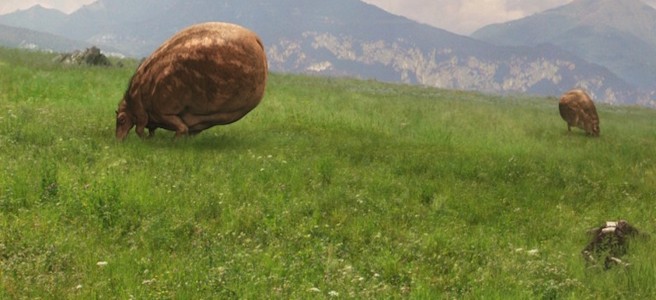Separated by lightyears, many of the galaxy’s creatures still share essential features. Hooves have long bonded creatures to sentient life in more ways than one.
One of the largest clades of mammals in the galaxy is the wildly diverse Ungulate (Ungulates or Ungulata). This article investigates two of the galaxy’s more well-known ungulate species, the shaak and eopie. Shaaks were found on the planes of Naboo, first appearing in The Phantom Menace and Attack of the Clones and later featuring prominently in Season 1 Episode 17 of The Clone Wars, “Blue Shadow Virus.” Eopies were natives to Tatooine that appeared throughout the galaxy and the Star Wars Prequel films.
Shaaks and Eopies
 In the Star Wars universe, (or GFFA), eopies were animals native to Tatooine. Their most similar Earth counterpart in both anatomy and in domestic utilization are camels. Camels sport three eyelids and large eyelashes that help to keep the blistering winds and whipping sand out of their eyes. Eopies had large external sockets that covered much of their eyes for a similar purpose. Both animals also possess flexible knees that allow them to bend low. This makes them useful for both mounting to traverse the desert landscape and carrying heavy supplies.
In the Star Wars universe, (or GFFA), eopies were animals native to Tatooine. Their most similar Earth counterpart in both anatomy and in domestic utilization are camels. Camels sport three eyelids and large eyelashes that help to keep the blistering winds and whipping sand out of their eyes. Eopies had large external sockets that covered much of their eyes for a similar purpose. Both animals also possess flexible knees that allow them to bend low. This makes them useful for both mounting to traverse the desert landscape and carrying heavy supplies.
The shaak of Naboo, on the other hand, are most closely related to cows. Both are plain-grazing animals known for their large bodies. Humans participate in the common practice of ranching, wrangling, and herding these animals. These animals enjoy wide-open fields and have long been the subject of sentient sport and feeding alike. What unites the eopie and shaak species is twofold: their morphology (the form of their legs and feet) and their shared history with sentient beings.
Morphology
The mammal class is distinguished by its members having mammary glands, by which they feed their young. While not enough data is available to prove the shaak or the eopie possess mammary glands, it may well still be appropriate to group them in the ungulate clade. Clades are odd taxonomic groupings that unite creatures between or across traditional taxons for any number of reasons. Often, they can be created based on morphological (physical form) similarities between animals. The clade pinniped, commonly known as seals, groups together all seal species even though they diverge greatly between fur seals and “true seals.” These kinds of groupings may not always be an indication of the closest genetic similarity possible, but it helps keep similar looking animals together in-between taxons. In the example of eopies and shaaks, much like how pigs and cows are taxonomically related by the morphology of their feet even though they diverge in many other ways, the eopie and shaak can be similarly grouped together.
Ungulates are hoofed mammals and can be divided between two orders: Perissodactyls, the odd-toed ungulates, and Cetartiodactyls, the even-toed ungulates. Quite literally, these animals have odd or even number of toes respectively. Amongst the odd-Toed ungulates are the equines (horse-like), rhinos, and tapirs; the even-toed order is populated by the cetaceans (whales, dolphins, and porpoises) ruminates, swine, and camels. While modern cetaceans do not actually have hooves, very recent research shows that they are so closely related to mammals that do, that scientists have begun classifying them amongst the true-ungulates. Members of this clade from both sides of the proverbial family have been domesticated and otherwise taken advantage of by sentient beings for both food and burden for all of history.
Domestication

The domestication of ungulates for burden and sustenance is likely tied together. It is far easier to feed from docile animals that are already in captivity. Animal husbandry morphed over time into workforce cultivation thanks to hundreds and thousands of years of selectively breeding the largest and sturdiest animals. Hoofed creatures would serve to carry heavy loads or plow fields the most efficiently thanks to their evolutionary advantageous long strides and abilities to run.
The domestication of shaak can be attributed to their enormous calves and blubbery nature. Meanwhile, the eopie have their long strides and highly flexible knees to thank. While the domestication of other creatures is often advantageous to sentient life, it is essential to remember that non-sentient life is still life; just as valuable as any other form. Shaak deserve open fields to roam. Eopie need rest after long traversals across the desert. Just because these creatures have features sentient life can benefit from does not entitle sentients to complete sovereignty over the autonomy and well-being of these creatures.
Eopie and shaak are not the lone ungulates in the galaxy. These two magnificent creatures have cousins all over, from the Core to the Unknown Regions, from the odd puffer-pig to and majestic (albeit, not TRUE-ungulate) purrgil. No matter the vast distances between the origins of each species, the advantages inherent in the physiology of hooves, even-toed and odd-toed alike, has reigned apparent across the galaxy.
